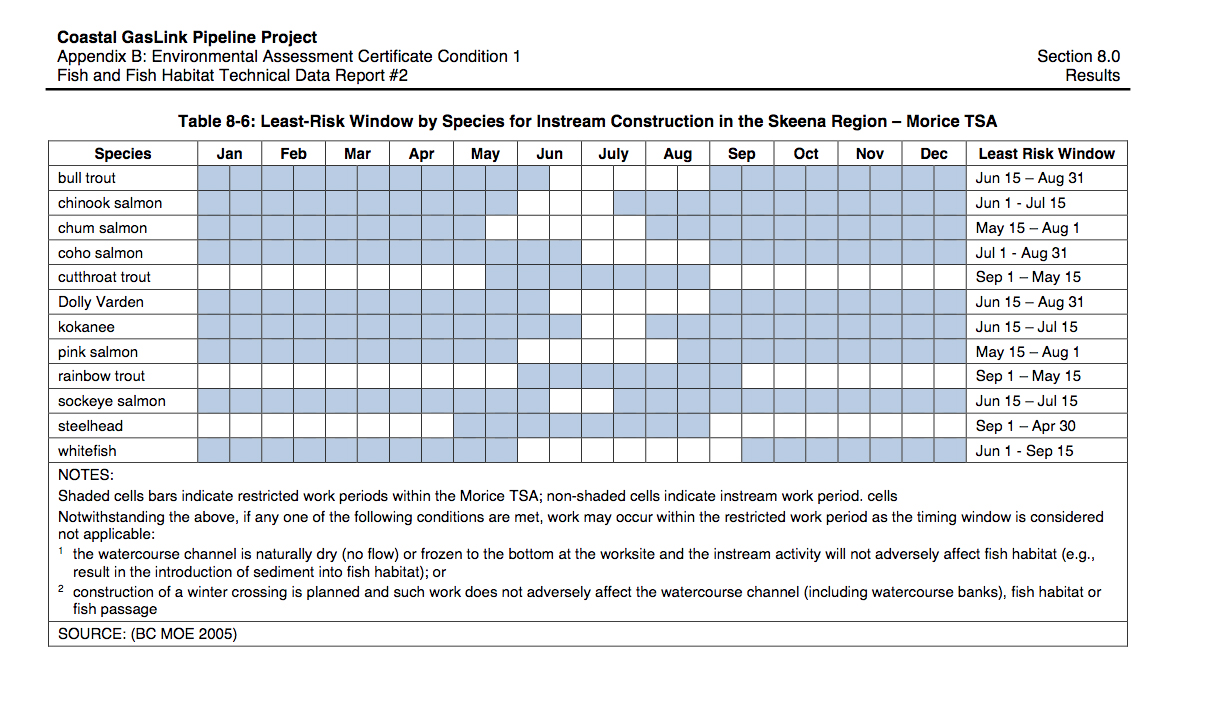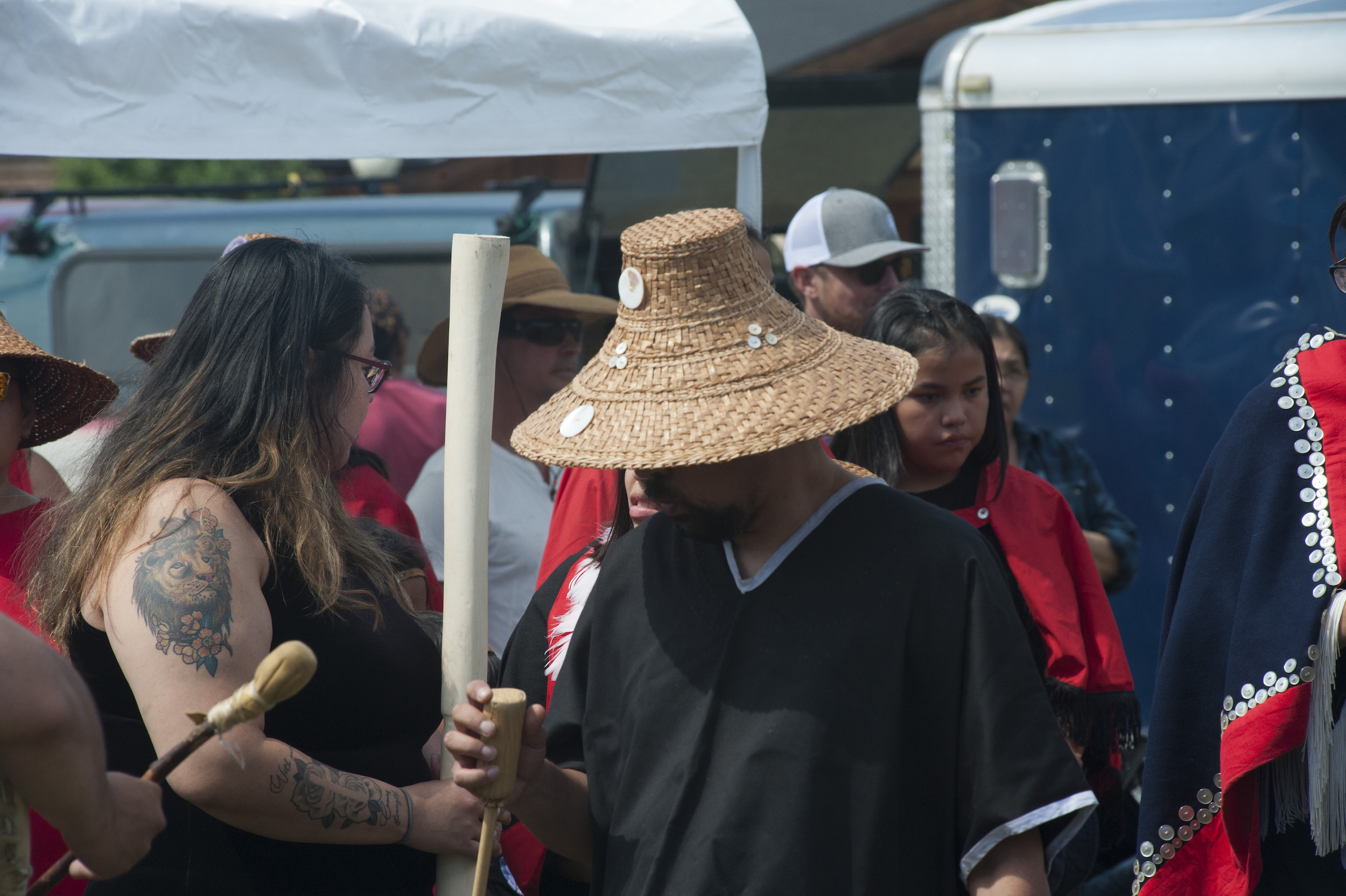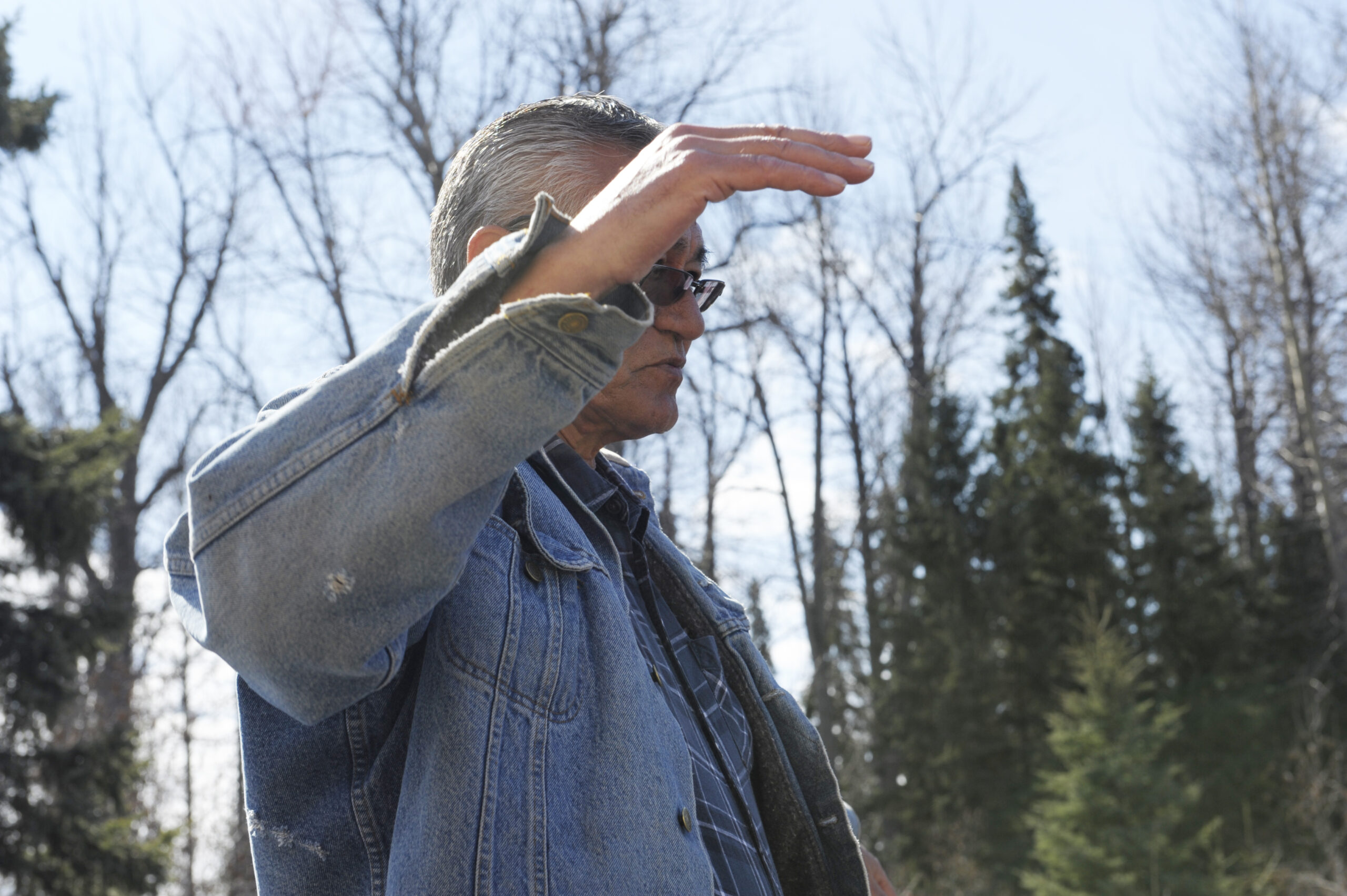
Hope for a huge, ancient and imperilled fish
First Nations are leading efforts to make sure lake sturgeon can find a home in...
Coastal GasLink is drilling under the Wedzin Kwa (Morice River) as spawning salmon lay their eggs throughout the river system.
The work is being done during a period outside of the “least-risk window” for in-stream construction, according to reports filed with the B.C. Environmental Assessment Office. Put another way, Coastal GasLink is putting its pipeline under the river at the riskiest time for salmon.
While laying the pipeline under Wedzin Kwa doesn’t include major construction directly in the river, the question of whether this work will impact the gravel beds where salmon lay their eggs remains unanswered by the company and provincial and federal regulators. Coastal GasLink has to drill to a depth of 11 metres under the river to complete the work.
Mike Ridsdale, environmental assessment coordinator with the Office of the Wet’suwet’en, an administrative body that works on behalf of the Hereditary Chiefs, said he was never satisfied with the company’s plans, which were approved by the B.C. government in 2014.
“The lack of sufficient adequate baseline data in terms of fish populations and least-risk windows was out to lunch — they were terrible,” he told The Narwhal. “Right now, there’s eggs that are in the gravel. All that vibration, what’s that going to do to them? Are they going to develop correctly?”

Michael Price, a fisheries biologist who has worked on projects in the watershed for over a decade, said he doesn’t know what effect the drilling will have on the eggs, but told The Narwhal he flew over the site a couple of weeks ago, conducting surveys of the spawning populations with the Wet’suwet’en fisheries department.
“It was striking: here is an industrial project taking place just upstream of spawning beds of salmon,” he said. “Any activity that’s taking place just upstream has the potential to influence those fish immediately downstream. In my mind, from a conservation perspective, it’s ludicrous.”
Apart from a handful of populations, wild salmon in watersheds from Alaska to California are suffering alarming declines and the impacts of climate change are wreaking havoc on their habitat. This work comes as B.C. is enduring a record-breaking fall drought, which has led to the deaths of thousands of salmon on the coast. Ridsdale said 33 per cent of all chinook in the Skeena River system come out of Wedzin Kwa. If the pipeline negatively affects that population, the impacts could be felt throughout the watershed.
“The problem is that we don’t know where that tipping point is,” he said. “If you look at what happened with the east coast cod and their downfall, it was because they didn’t know the tipping point — and they reached it and surpassed it and, bam, the cod disappeared.”

TC Energy, the parent company of the pipeline project, did not directly answer The Narwhal’s questions about potential impacts and what mitigation measures are in place.
“Coastal GasLink follows the requirements and regulations of our regulators, the B.C. Environmental Assessment Office and the Oil and Gas Commission,” a spokesperson wrote in an email. “Our work is fully authorized and permitted and has the unprecedented support of local and Indigenous communities across the project route. It is being completed in accordance with all permits, plans and requirements.”
The Narwhal followed up with the company to try to understand why they are laying pipe during such a critical moment for salmon. The company said “the work will not affect spawning fish or incubating eggs” but did not answer questions about mitigation and monitoring.
B.C.’s Environmental Assessment Office told The Narwhal the company is required to complete a detailed plan which includes mitigation measures such as “limiting activities within sensitive riparian areas and shoreline, storing excavated materials away from all bodies of water, maintaining erosion and sediment control at all bodies of water, properly disposing of water that contains sediment and continued post-construction monitoring for five years.”
Ridsdale isn’t convinced.
“When a company comes in [with] assurances that they’re going to do everything correctly and then make mistakes on the land, I know all they have to do is issue a report and not supply any data to back it up. That is not the way to do business in British Columbia,” he said.
Coastal GasLink has continually been in non-compliance with provincial regulations since starting construction in 2019 and has received more than $240,000 in fines for environmental infractions.
The environmental assessment office noted it has conducted numerous inspections and recently issued another warning because the company failed to complete habitat surveys of “any red- and blue-listed plants and ecological communities.” Anything on the red list is considered endangered and blue-listed species are of “special concern” — both classifications set conservation goals aimed to protect species from extinction.
“This company has been in and out of compliance all the way along with this project and what our government has demonstrated is an extreme lack of willingness to hold them accountable to the environmental regulations that we have,” Adam Olsen (SȾHENEP), Green party representative and member of Tsartlip First Nation (WJOȽEȽP), told The Narwhal.
On Oct. 5, Olsen called on George Heyman, Minister of Environment and Climate Change Strategy, to issue a stop-work order. Heyman’s response noted the inspections and financial penalties, adding the province entered a compliance agreement with the pipeline company in the summer.
“We recently added to our ability to control what this company does and keep a watchful eye over them and take appropriate action by entering into a compliance agreement, which is in addition to the conditions that exist in the certificate,” Heyman said in the response.
Olsen scoffed at the response.
“This provincial government is entirely and totally invested and acting like they are captured by the oil and gas industry,” he said.
A spokesperson with the Ministry of Environment and Climate Change Strategy told The Narwhal compliance and enforcement officers are actively monitoring the project.
“The site may be inspected during drilling, however, planning details are not to be shared in advance to ensure our compliance and enforcement monitoring is not compromised in any way.”
The company is currently restricting all access to the worksite, including prohibiting Wet’suwet’en Hereditary Chiefs from entering for purposes of monitoring.
“Definitely they’re hiding something,” Dinï ze’ (Hereditary Chief) Na’Moks said. “We don’t know what’s going on, we don’t get any information about it. They just simply go ahead — and that’s with the full backing of the province and the federal government.”
“When they’re talking about the environmental crisis and climate change and they’re gonna do this, that and everything, the simplest thing they could do is stop killing the food that we rely on, the fresh water,” he added. “Like, wow, where exactly are they heading?”

The Wedzin Kwa crossing is deemed “medium risk” which means it has “potential for construction activities to adversely affect fish and fish habitat at the crossing and downstream from the crossing,” according to the report outlining conditions the project has to adhere to.
Figuring out when the safest time to do work in the river and its tributaries was based on previously available fisheries data and on-the-ground research, including a 2019 snorkel survey. The report notes “there are important chinook salmon spawning and holding areas in the mainstem Morice River between the confluence of Lamprey Creek and the outlet of Morice Lake, including at the project crossing location.”
The pipeline also has to cross Lamprey Creek (Ts’elkay Kwe), upstream from the confluence. That crossing will be in-stream.
Brian Huntington, co-founder of the Skeena Watershed Conservation Coalition, said in late September he documented steelhead, chinook, coho, sockeye and pink salmon in the river between its headwaters at Wedzin Bin (Morice Lake) and the Unist’ot’en Healing Centre, just downriver of the pipeline crossing currently under construction. Chinook populations are “well below average” and the past three generations have seen a 31 per cent decline in returns, according to the Pacific Salmon Foundation.
The river is “so unique, why would they attempt anything like this?” Na’moks said. “I often wonder, what is DFO doing? Salmon are their bailiwick, right?”
The Narwhal requested an interview with a Fisheries and Oceans Canada biologist but was told the project falls under provincial jurisdiction. The federal agency did not answer any questions prior to publication.
In August, Joyce Murray, the federal minister, and Josie Osborne, B.C.’s Minister of Land, Water and Resource Stewardship, doubled the funding for the British Columbia Salmon Restoration and Innovation Fund. The goal is to support “sustainable, resilient and prosperous fisheries” and “projects that address climate change impacts to salmon, priority salmon populations and Indigenous participation and Traditional Knowledge.”
“Just upstream of [the Coastal GasLink project] is a population of sockeye salmon that Fisheries and Oceans Canada has signed off on a rebuilding plan with the Wet’suwet’en,” Price said. “And yet industrial activities like this continue to be approved, and go ahead. It’s just at odds with the direction we need to go if we’re serious about wild salmon persisting and thriving in systems like this.”
To Ridsdale, the unknowns are terrifying when the survival of salmon is at stake.
“The lack of information being given in this Coastal GasLink project that was given a certificate by the British Columbia Environmental Assessment Office, is an injustice to the Wet’suwet’en people,” he said.
“How can the Wet’suwet’en have any assurance of the protection of values when the supplied conditions do not recognize Wet’suwet’en Title [and] Rights and associated interests on our territories? We are caretakers of the land: we know what is needed and how to take care of it.”
Updated on Oct. 20, 2022, at 4:31 p.m. PT: A previous version of this story said that Coastal GasLink recently informed Wet’suwet’en fisheries technicians it would be conducting blasting activity to complete the work. Following publication the company told The Narwhal via email that “Coastal GasLink is not carrying out blasting at the Morice River.” The story has been updated to remove references to blasting taking place.
Get the inside scoop on The Narwhal’s environment and climate reporting by signing up for our free newsletter. Angello Johnson’s shoulders burn, and his arms...
Continue reading
First Nations are leading efforts to make sure lake sturgeon can find a home in...

We’re excited to share that an investigation by The Narwhal is a finalist for the...

A new documentary, Nechako: It Will Be a Big River Again, dives into how two...
